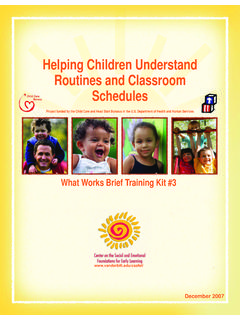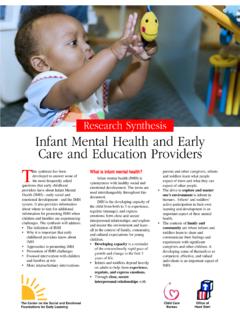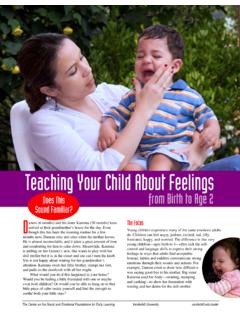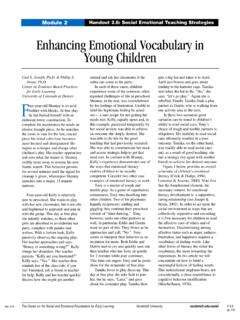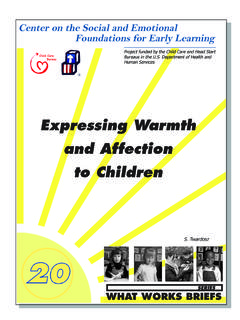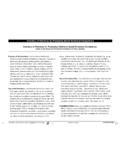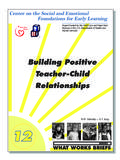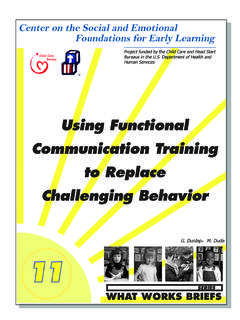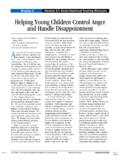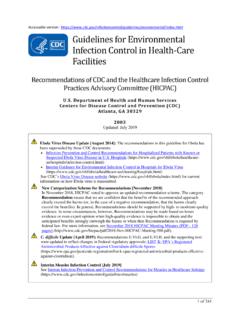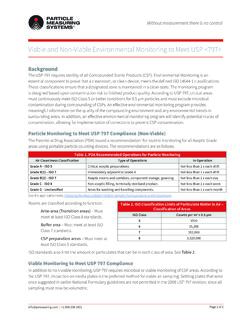Transcription of Using Environmental Strategies to Promote Positive Social ...
1 Center on the Social and Emotional Foundations for Early Learning Project funded by the Child Care and Head Start Bureaus in the Department of Health and Human Services Using Environmental Strategies to Promote Positive Social Interactions T. Bovey P. Strain 6 WHAT WORKS BRIEFS. SERIES. This What Works Brief is part of a continuing series of short, other caregivers support young children's Social and easy-to-read, how to information packets on a variety of emotional development. They include examples and vignet- evidence-based practices, Strategies , and intervention tes that illustrate how practical Strategies might be used in a procedures. The Briefs are designed to help teachers and variety of early childhood settings and home environments. Painting at an easel, playing a game on a classroom computer, What Are Environmental Strategies to doing a puzzle, and playing on a swing are all examples of Increase Positive Social Interactions?
2 Preschool activities that young children enjoy. But these activi- Environmental Strategies are changes and adaptations that can be ties have something else in common. They are all primarily done made to a classroom's physical environment , schedule, activi- individually, limiting the child's opportunities for Positive peer ties, and materials to encourage Positive Social interactions Social interactions. However, teachers and other caregivers can between children in the classroom. One advantage of environ- make many adaptations to the environment to encourage Positive mental Strategies is that they require little adult intervention once Social interactions between children in the classroom. the planning and organization are complete. Some of the changes and adaptations that teachers and other One advantage of Environmental Strategies is that caregivers can make to maximize and Promote Positive Social they require little adult intervention once the interactions include examining: planning and organization are complete.
3 Group Composition, Classroom Activities, and Classroom Materials. I t's 15 minutes before the children arrive at the Douglas County Early Childhood Center, and Mr. Ron and the other caregivers are busy preparing the room for the day. The most important way that caregivers can influence group composition is to make certain that children with good Social Because it's Monday and the start of a new storybook and skills are always grouped or encouraged to be involved in theme, the teachers are busy putting away materials from activities with peers who are less skilled socially. Providing the past two weeks and getting out new materials. They have access to socially competent peers, while a necessity, is not planned ahead and know that during center time the block enough to Promote Positive Social behaviors. and art centers are going to be open. Because the art center Arranging the physical environment and selecting activities and has been closed for the past two weeks, they are expecting it materials can also encourage peer interactions.
4 For example, to be very popular. The block center, however, was open last caregivers can: week, so to try and maintain the children's interest in playing there, the teachers have replaced the cars and the Limit the number of centers available in the classroom. garage that the children were Using with the blocks with all By limiting the number of centers open and rotating or kinds of animals, another favorite accessory in the block changing them periodically ( , weekly or every other center. In addition, for the next two weeks, the caregivers week), caregivers can increase the chances that peer interac- are going to exchange the bikes and tricycles they've been tions will take place. For example, if a classroom has 10 open Using outside for two wagons that parents have donated. centers and 14 children, on average only 1 or 2 children will be in a center at a time. By closing 2 or 3 of those centers, The caregivers' last task before the children arrive is to plan caregivers can increase the number of children per center, where the children are going to sit at circle time and at and they can then rotate the centers that are open, keeping snack time.
5 They talk about seating Angel, a child with poor them novel and interesting. Social skills, next to Leah, a very Social peer. The caregivers plan to have Leah help pass out the snack, and knowing that Use interesting and novel toys and materials. Although Angel likes snack, they count on at least a few good Social children enjoy their familiar toys and materials, new or novel interactions between the two children. They also know that items in the environment can increase Social interactions. An Leah will be a good model for motor actions and finger- excellent cost-efficient way to maintain newness of plays for Angel during circle time, and they know that she materials is to use a toy rotation system. A toy rotation can help pass out and collect props that they plan to use. system simply involves changing and rotating the materials available to the children. Caregivers can rotate whole centers as described above or simply change the materials available in a center, as Mr.
6 Ron and the other caregivers did at the require time and planning outside of the classroom day, results block center in the example above. are often seen with little direct teacher involvement with the children. Results are truly a result of the environment . For Use toys and materials that will Promote cooperation and example, replacing the tricycles with the wagons requires time sharing. A number of commonly available toys and materials before the children arrive, but once the materials are out, work best and tend to be more fun when two or more children tend to give each other rides and play together sponta- children use them together. Materials such as teeter-totters, neously, without additional teacher direction or support. rocking boats, wagons, and other large play items require that children coordinate their actions. By replacing the bikes and Environmental changes can be further enhanced by combining tricycles with wagons that one child can pull another child these Strategies with specific Social skills instruction such as the (or two children) in, Mr.
7 Ron has improved the chances of Peer-Mediated Strategies outlined in What Works Brief #8, titled getting Positive Social interactions while the children are Promoting Positive Peer Social Interactions. outside. Another example might be replacing the easels that are used in the art center for painting with large pieces of paper taped on the classroom wall so that children can paint Who Are the Children Who Have together. Participated in Research on Using Environmental Strategies to Increase Keep children near socially competent peers. Being near more socially competent children can both increase Positive Positive Social Interactions? interaction and reduce problem behaviors. Adults can Research on Environmental Strategies to increase Positive peer encourage this close contact by making sure that planned interactions has been conducted on a wide range of children, activities are meaningful and fun for all children and by including 2- to 5-year-old typically developing children and giving children time and attention when they are playing children with a variety of developmental and Social disabilities.
8 Together. For example, a caregiver might say, Wow, this is so Intervention efforts have been successful with both typically great that all of you are playing together in housekeeping. developing children and children with mild to moderate disabili- Positioning children can also help encourage interaction. ties, although research has indicated that for children with more Instead of having two children stand next to each other on severe Social needs, intervention effects may take longer. Boys one side of the water table, caregivers can place one child on and girls benefit equally from these interventions. Because these the end or have a child on each side of the table so they can Strategies are primarily based on teacher planning and organiza- face each other and see what the other child is doing. tion, they can be easily adapted to meet the needs of culturally and linguistically diverse children.
9 For Environmental Strategies such as those outlined above to be used effectively, caregivers need planning time to examine the daily schedule, physical environment , and classroom activities. Being near more socially competent children can both Additionally, caregivers must commit to daily implementation of increase Positive interaction and reduce problem these Strategies around routine activities in the classroom to behaviors. achieve maximum benefits. For example, if at circle time, a caregiver positions Matt (a Social peer) next to Bryan (a child with Social deficits) but doesn't provide appropriate activities or materials, Bryan may not talk to or interact with Matt. Thus, the caregiver has missed opportunities to encourage peer interac- A s we look back at Mr. Ron's classroom, we find that the Environmental Strategies that the caregivers put in place that morning are working well.
10 During circle time, tions. Likewise, if caregivers provide toys that are intended for Leah helped Angel by modeling the motor actions to Five one child to use at a time, or if caregivers don't rotate toys and Little Monkeys Jumping on the Bed, and she passed Angel a materials regularly, they lose valuable opportunities for Social monkey used as a prop for the song. Similarly, at snack, Leah interaction that would have been created by making these gave snacks to all the children at her table, including Angel, relatively simple adaptations to the environment . creating several opportunities for Positive peer interactions. During center time, the newly opened art center was popular as expected, and by limiting the number of paint cups Why Are Environmental Strategies available, the caregivers created additional opportunities for Important for Increasing Positive Social peer interactions.
